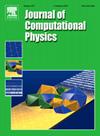过渡交通流模型的中心迎风方案
IF 3.8
2区 物理与天体物理
Q2 COMPUTER SCIENCE, INTERDISCIPLINARY APPLICATIONS
引用次数: 0
摘要
相变模型是一类重要的非平衡连续交通流模型,具有复制复杂交通现象、保持各向异性、适应自动驾驶车辆等特点。然而,其复杂的数学特征(如不连续解域)给交通流理论带来了数值挑战,并限制了其探索。本文的重点是开发一种鲁棒和精确的相变交通流模型的数值方法:我们提出了一种二阶半离散的中心迎风格式,专门为相变模型设计。这种新颖的方案将投影结合到适当的流域上,确保增强对不连续性的处理,并保持物理一致性和准确性。我们通过广泛和具有挑战性的数值测试证明了所提出方案的有效性,展示了它们在促进相变交通流建模的进一步研究和应用方面的潜力。相变模型嵌入“时间间隙”的能力——自动交通控制中的关键因素——作为一个保守变量与自动车辆的控制逻辑无缝地对齐,在未来的应用中呈现出巨大的潜力,现在提出的数值方案极大地促进了探索这种潜力。本文章由计算机程序翻译,如有差异,请以英文原文为准。
Central-upwind scheme for the phase-transition traffic flow model
Phase-transition models are an important family of non-equilibrium continuum traffic flow models, offering properties like replicating complex traffic phenomena, maintaining anisotropy, and promising potentials for accommodating automated vehicles. However, their complex mathematical characteristics such as discontinuous solution domains, pose numerical challenges and limit their exploration in traffic flow theory. This paper focuses on developing a robust and accurate numerical method for phase-transition traffic flow models: We propose a second-order semi-discrete central-upwind scheme specifically designed for phase-transition models. This novel scheme incorporates the projection onto appropriate flow domains, ensuring enhanced handling of discontinuities and maintaining physical consistency and accuracy. We demonstrate the efficacy of the proposed scheme through extensive and challenging numerical tests, showcasing their potential to facilitate further research and application in phase-transition traffic flow modeling. The ability of phase-transition models to embed the “time-gap”—a crucial element in automated traffic control—as a conserved variable aligns seamlessly with the control logic of automated vehicles, presenting significant potential for future applications, and the proposed numerical scheme now substantially facilitates exploring such potentials.
求助全文
通过发布文献求助,成功后即可免费获取论文全文。
去求助
来源期刊

Journal of Computational Physics
物理-计算机:跨学科应用
CiteScore
7.60
自引率
14.60%
发文量
763
审稿时长
5.8 months
期刊介绍:
Journal of Computational Physics thoroughly treats the computational aspects of physical problems, presenting techniques for the numerical solution of mathematical equations arising in all areas of physics. The journal seeks to emphasize methods that cross disciplinary boundaries.
The Journal of Computational Physics also publishes short notes of 4 pages or less (including figures, tables, and references but excluding title pages). Letters to the Editor commenting on articles already published in this Journal will also be considered. Neither notes nor letters should have an abstract.
 求助内容:
求助内容: 应助结果提醒方式:
应助结果提醒方式:


